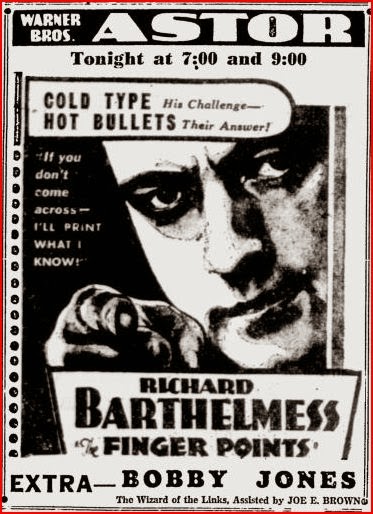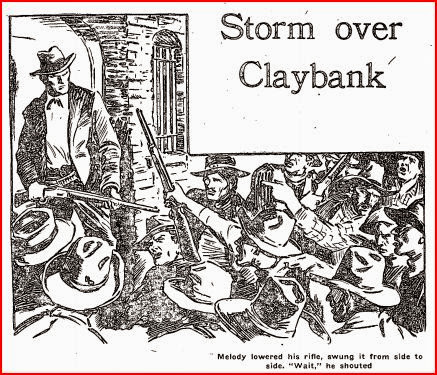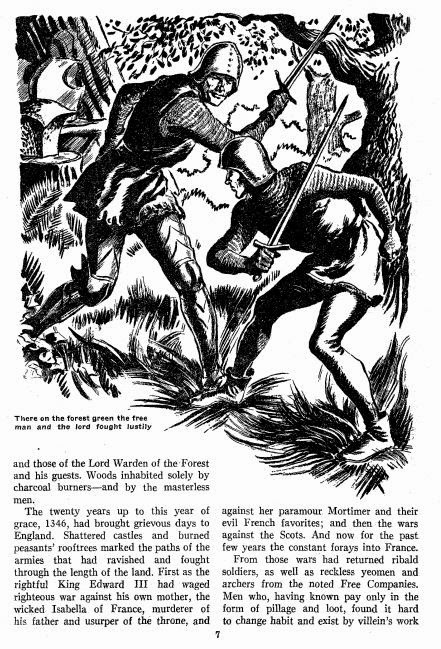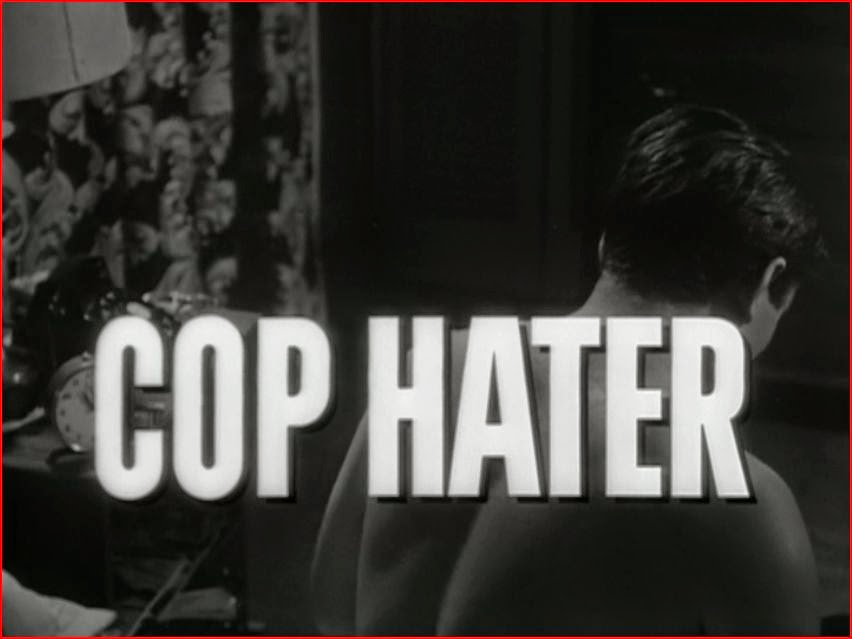
As for the co-cover story, the first chapter of Lords of Creation introduces us to two-in-one author Eando Binder. Sound out that first name and you get the idea. Eando combines the brothers Earl and Otto Binder. Otto is better known in some quarters as the main writer of Captain Marvel's adventures in the golden age of comics, while Eando's best known creation is probably the conscientious robot Adam Link. Lords is a work of naive satire in that the Binders really seem to believe that they're reversing a typical theme of "fantastic" literature. It's yet another sleeper-awakens tale in which a modern-day American revives from suspended animation several thousand years in the future. The twist in the opening chapter is that the sleeper expects to see a word of technological marvels and utopian civilization, and takes a stubborn long time to realize that the world of 5000 A.D. is actually stuck in a "Second Stone Age." A few wise men have mastered enough of our English language to communicate with him through crudely written messages, but the culture has reverted almost to a medieval level. The Binders expect this to shock readers, but my impression is that, as in our anxious time, fantasists of the 1930s quite often imagined a dark future. Things were pretty bad when Buck Rogers woke up, for instance, and in Argosy's last-such serial, Minions of the Moon, the sleeper awakens to find some humans reverting to Viking culture. The trend may have been different in the actual science-fiction pulps which may be the actual target of the Binders' satire. Lords may be ahead of its time in blaming the collapse of civilization on resource exhaustion, but the resource in question isn't oil but metal. Overproduction exhausted the world's ores, forcing humanity to return to wood, stone and animal power -- but once the Binders establish this misfortune, they tease us by closing with the sight of an airplane flying over the primitive future settlement. That's definitely a good way to keep us reading next week.
To round out the serials, the MacIsaac-Harkins dialect tale River Rogues meanders to its conclusion while Theodore Roscoe adds an international cast of suspects or victims to Remember Tomorrow, his mystery teasing murders in 1939 by undead casualties of the last Great War. It's still too early to tell whether Roscoe will keep it creepy or end up debunking it all. That uncertainty works when our hero, an American mystery writer, momentarily doubts his sanity when a German shows up asking directions to a military unit's position. He could be a ghost, but he's actually a tourist doing research on the battlefield -- or at least that's all he is for now. Written well before the second Great War broke out in September 1939, Roscoe's serial is certainly ominously timely, and it should also be fun to see whether he paints himself into a corner, and whether he escapes anyway.
The stand-alones this week include an unlikely crime romance from Donald Barr Chidsey, "Little Rat, What Now?" Bennett Foster's solid western, "Spurs for Sacatone," Richard Howells Watkins's sea story "Ticket at Twenty," in which a youthful first mate must thwart sabotage by his own captain, and Brice Purcell's weird tale "The Aztec Heart," in which the ancient Mexican blood keeps an otherwise sophisticated modern man alive after a fatal encounter in Europe so he can die the traditional way, sacrificed on a pyramid. Overall this one is a pretty entertaining mix of genres and settings with two strong serials and most of the rest quite readable. We'll have a new serial next week, and our first encounter in this series with the reigning master of Foreign Legion stories, Georges Surdez, along with plenty more besides.
TO BE CONTINUED


 M
M




 F
F Y
Y Big Hearted Herbert was released on the other side of the historic dividing line, in October 1934. In another adaptation of a play, MacMahon is the wife of Guy Kibbee (aged 52). The actors first met on-screen in Gold Diggers of 1933, but were teamed formally beginning with May 1934's The Merry Frinks, a dysfunctional-family comedy. After Herbert, they teamed up three more times over the next year, including an adaptation of Sinclar Lewis's Babbitt in which Kibbee played the archetypal bourgeois "boob" of the 1920s. For comparison's sake, Preston Foster was one year MacMahon's junior. As for Kibbee, Herbert arguably marks his domestication as well as MacMahon's. He could be a satyr in Pre-Code comedies, all the more transgressive for his age and sometimes-repulsive manner. But in Herbert both actors are thoroughly desexualized, and the film plays more like a TV sitcom. MacMahon does have top billing on-screen but Kibbee understandably dominates the film as the sort of reactionary who might be more recognizable today than his and Lewis's Babbitt is. Herbert Kalniss is a self-made man who rose from humble plumber to self-consciously humble bath and sink manufacturer, the sort who boasts incessantly and ad nauseum of being a "plain man" while spewing contempt for alleged elitists of all sorts: collegians, lawyers and other professional men. In short, the title is ironic if not sarcastic. MacMahon is the long-suffering wife, a more intelligent Edith Bunker who turns the tables on her husband after he humiliates his potential in-laws -- his daughter has returned from college with a fiance as a fait accompli -- with his tirades and arrogant crudities. For revenge, or simply to teach a lesson, she embarrasses Herbert in front of his business cronies by dressing down (with her kids) and behaving like a complete rube. That's the payoff -- well, she does threaten to leave him before he finally repents in characteristically grudging fashion -- and it just seems childish, sitcom-ish. Of course, you can't say a film like this wouldn't exist in the Pre-Code era, but Big Hearted Herbert seems like what the powers behind Code Enforcement wanted movies to be. It's a mildly entertaining movie entirely on the strength of Kibbee's stormcloud of a performance, but I'd understand if people find Herbert hateful rather than funny. The sad thing about it, especially if you happened to watch Heat Lightning first, as I did, is how diminished, desexualized and domesticated Aline MacMahon is, as if the actress of Herbert is the MacMahon Code Enforcement wanted, for reasons lost to time. What a waste.
Big Hearted Herbert was released on the other side of the historic dividing line, in October 1934. In another adaptation of a play, MacMahon is the wife of Guy Kibbee (aged 52). The actors first met on-screen in Gold Diggers of 1933, but were teamed formally beginning with May 1934's The Merry Frinks, a dysfunctional-family comedy. After Herbert, they teamed up three more times over the next year, including an adaptation of Sinclar Lewis's Babbitt in which Kibbee played the archetypal bourgeois "boob" of the 1920s. For comparison's sake, Preston Foster was one year MacMahon's junior. As for Kibbee, Herbert arguably marks his domestication as well as MacMahon's. He could be a satyr in Pre-Code comedies, all the more transgressive for his age and sometimes-repulsive manner. But in Herbert both actors are thoroughly desexualized, and the film plays more like a TV sitcom. MacMahon does have top billing on-screen but Kibbee understandably dominates the film as the sort of reactionary who might be more recognizable today than his and Lewis's Babbitt is. Herbert Kalniss is a self-made man who rose from humble plumber to self-consciously humble bath and sink manufacturer, the sort who boasts incessantly and ad nauseum of being a "plain man" while spewing contempt for alleged elitists of all sorts: collegians, lawyers and other professional men. In short, the title is ironic if not sarcastic. MacMahon is the long-suffering wife, a more intelligent Edith Bunker who turns the tables on her husband after he humiliates his potential in-laws -- his daughter has returned from college with a fiance as a fait accompli -- with his tirades and arrogant crudities. For revenge, or simply to teach a lesson, she embarrasses Herbert in front of his business cronies by dressing down (with her kids) and behaving like a complete rube. That's the payoff -- well, she does threaten to leave him before he finally repents in characteristically grudging fashion -- and it just seems childish, sitcom-ish. Of course, you can't say a film like this wouldn't exist in the Pre-Code era, but Big Hearted Herbert seems like what the powers behind Code Enforcement wanted movies to be. It's a mildly entertaining movie entirely on the strength of Kibbee's stormcloud of a performance, but I'd understand if people find Herbert hateful rather than funny. The sad thing about it, especially if you happened to watch Heat Lightning first, as I did, is how diminished, desexualized and domesticated Aline MacMahon is, as if the actress of Herbert is the MacMahon Code Enforcement wanted, for reasons lost to time. What a waste.
 T
T




 T
T








